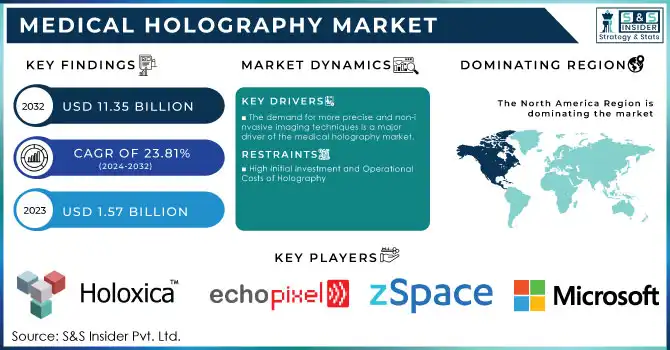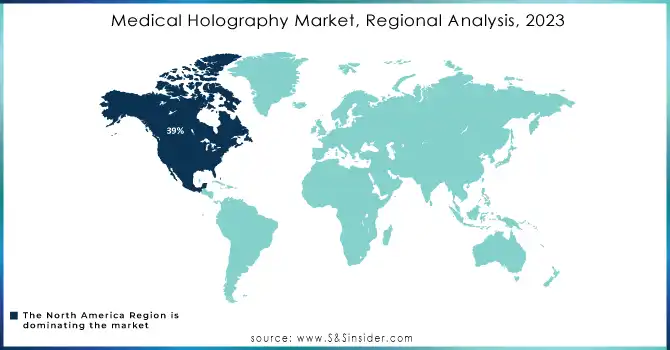Medical Holography Market Report Insights:
The Medical Holography Market Size was valued at USD 1.57 billion in 2023 and is expected to reach USD 11.35 billion by 2032, growing at a CAGR of 23.81% from 2024-2032.

Get More Information on Medical Holography Market- Request Sample Report
The medical holography market is experiencing substantial growth, driven by the increasing demand for advanced imaging solutions in healthcare and medical education. Holographic imaging offers a transformative approach, enabling 3D and 4D visualizations of anatomical structures, which significantly enhances diagnostic accuracy and medical training. As a result, medical holography is being adopted in a variety of settings, from hospitals and clinics to research laboratories and academic institutions.
Recent developments along with key trends including the integration of AI and cloud technologies to improve imaging precision and accessibility. This growth is fueled by the increasing adoption of holography in medical imaging, biomedical research, and educational applications.
The market's expansion is further supported by technological advancements, such as the development of holographic displays and interactive 3D models. Companies like HoloTech Switzerland AG are contributing to this progress, offering innovations that are revolutionizing how healthcare professionals visualize and understand complex anatomical data.
Additionally, the increasing investment in research and development, along with a growing focus on non-invasive diagnostic methods, is expected to propel the demand for medical holography tools. In March 2024, Siemens Healthineers launched the Anatomy Hologram app on Apple Vision Pro, Such an application may find potential applications in patient communication, medical education, and surgical planning.
Medical Holography Market Dynamics
Drivers
-
The demand for more precise and non-invasive imaging techniques is a major driver of the medical holography market.
Traditional imaging methods such as X-rays and MRIs, while valuable, can be limited in terms of spatial visualization. Holographic imaging allows for three-dimensional and four-dimensional reconstructions of complex anatomical structures, enabling healthcare professionals to better understand and diagnose diseases. This technology is especially beneficial in the fields of oncology, orthopedics, and neurology, where accurate visualization is crucial for treatment planning and surgery. As the global healthcare industry prioritizes improved diagnostics and treatment, holography is gaining traction for its ability to offer more detailed, immersive, and interactive models.
-
The increasing adoption of holography in medical education and training.
Medical institutions are turning to 3D holograms to improve the training of doctors, surgeons, and medical students. This technology allows for interactive, real-time visualizations of the human body, which enhances the learning experience by providing an immersive and detailed understanding of human anatomy. The ability to manipulate 3D holograms and visualize complex structures from various angles offers a significant advantage over traditional textbooks or 2D images. As the demand for highly trained medical professionals increases, the use of advanced simulation tools like medical holography is expected to expand.
Restraint
-
High Initial Investment and Operational Costs of Holography
One of the primary constraints hindering the growth of the medical holography market is the high initial investment and operational costs associated with adopting and maintaining holographic technologies. Specialized equipment such as advanced holographic displays, 3D imaging systems, and high-performance computing infrastructure require significant capital outlay. Furthermore, these technologies often necessitate specialized training for healthcare professionals, which adds additional costs. The high price point for both hardware and software, coupled with ongoing maintenance and operational expenses, may deter smaller medical institutions, research labs, and educational centers from investing in these technologies. This financial barrier to entry limits the widespread adoption of medical holography, particularly in emerging markets where budget constraints are more pronounced.
Medical Holography Market Segment Analysis
By product
In 2023, the medical holography market share was dominated by holographic displays with a market share of 37%. This is quite largely attributed to the continuous improvement of the display technology, enhancing their capability in medical diagnosis and post-operative treatment. The holographic display enables clinicians to have three-dimensional visualizations of complex anatomical structures that inform better decision-making. Significant investment in this field is also driving growth. For example, VIVIDQ, which is a UK deep-tech startup, has accessed USD15 million to innovate technology that turns conventional displays into holographic ones.
Holographic Microscope has the fastest growth in the holographic microscope segment as well, which is forecast to have a higher CAGR of 25% during the forecast period from 2023 to 2032. The same can be attributed to the wide range of technological capabilities of holographic microscopes, that are being applied in almost all medical applications. Included in these are: label-free cell cycle analysis, cell counting, morphological analysis, studies of nerve cells, and red blood cell (RBC) analysis, among others. The advantages offered by holographic microscopes in providing high-precision, non-invasive cellular imaging make them increasingly valuable in both research and clinical contexts.
By application
In 2023, the medical imaging segment was the dominant in the medical holography market. This application is important to doctors for the diagnosis and treatment of various medical conditions. Medical imaging allows doctors to view and analyze structures from within the body before surgery operations, which improves precision while reducing risks. It has been very effective in identifying hormonal imbalances and abnormal growth patterns, eliminating the need for more invasive testing methods.
The fastest-growing segment is projected to be medical imaging, with a compound annual growth rate (CAGR) of 24% from 2023 to 2032. Its growth is mainly associated with the increased adoption of holographic imaging in tissue abnormality detection, which is an important aspect in the diagnosis and monitoring of cancers. An estimated 1.8 million new cancer cases are reported yearly in the United States, and one-third of the diseased population dies. Owing to holographic imaging, oncologists and radiologists can evaluate cancer cell progression much more effectively and predict prognosis based on tissue analysis. This advancement is likely to shed much-needed light on cancer treatment and enhance medical professionals' capabilities.

Medical Holography Market Regional Analysis
In 2023, North America dominated the medical holography market with the largest market share of 39%. This is due to the region making huge investments in advanced medical infrastructure and paying close attention to excellence in healthcare. For example, about 17% of the GDP in the United States is spent on healthcare annually, supporting innovation and technology integration. Other than that, countries like Canada have been registering an increase in the use of medical imaging technologies diagnosing cancer, where about 250,000 new cases are diagnosed annually.
The fastest growth is expected to come from the Asia-Pacific region in the medical holography market during the forecast period. This is due to increased government investments in healthcare infrastructures, especially in South Korea which has always been a forerunner in healthcare technology, and the health budget of India has been increased very significantly. These factors are influencing the healthcare market in the region and are accelerating the adoption of medical holography technologies.

Key Players in Medical Holography Market
-
Holoxica Ltd (HoloMedical Visualisation Suite, 3D Digital Holographic Displays)
-
RealView Imaging Ltd (Holoscope-i, Holographic Guidance for Interventional Procedures)
-
EchoPixel, Inc. (True 3D Viewer, Holographic Virtual Reality Surgical Solutions)
-
zSpace, Inc. (zSpace Healthcare Education Platform, Augmented and Holographic Training Modules)
-
Microsoft Corporation (HoloLens 2, Dynamics 365 Remote Assist for Medical Applications)
-
Mach7 Technologies (Holographic Image Viewer, Mach7 Enterprise Imaging Platform with 3D Capabilities)
-
Leia Inc. (Lume Pad, Holographic 3D Tablets for Medical Imaging)
-
Looking Glass Factory Inc. (Looking Glass Pro, Looking Glass Portrait)
-
Phase Holographic Imaging (PHI) AB (Holomonitor M4, Holomonitor App Suite for Live-Cell Imaging)
-
3D Systems, Inc. (D2P Software, Holographic Surgery Simulation Tools)
-
NanoLive SA (CX-A Holographic Imaging Platform, 3D Cell Explorer)
-
Vizitech USA (Z-Space 3D Holographic Systems, Medical Education Holographic Simulators)
-
HoloTech Switzerland AG (Holographic Patient Imaging Systems, 3D Surgical Navigation Displays)
-
Realfiction Holdings AB (Dreamoc Medical Displays, Holographic Clinical Communication Systems)
-
Dmetrix Inc. (HoloTable for Medical Imaging, HoloViewer 3D Diagnostic Software)
-
Voxel Bay (HoloHealth Imaging Solutions, Virtual Holographic Anatomy Tools)
-
Ampronix (Medical Holographic 3D Displays, Surgical 3D Visualization Systems)
-
VisualSonics (FUJIFILM) (Holographic Ultrasound Imaging Systems, High-Frequency Holographic Transducers)
-
MDH Hologram Ltd. (3D HoloScreen for Medical Applications, HoloLens Integration Tools)
-
Luxexcel (Holographic Lenses for AR in Surgery, Optical 3D Printed Medical Solutions)
Recent Developments
-
Holoxica Ltd (October 2024): Holoxica Ltd continues to innovate in medical visualization with its holographic displays. The company focuses on providing high-resolution, interactive 3D anatomical models that aid in diagnosis and treatment planning. This is part of a growing trend in the industry to use holography for more accurate, real-time medical imaging
-
EchoPixel (September 2024): EchoPixel has enhanced its holographic surgery planning platform, integrating real-time 3D interactive visualizations. The technology allows surgeons to interact with patient data, such as CT scans, in a 3D space, significantly improving the accuracy of surgical procedures
-
Microsoft Hololens 2 (June 2024): Microsoft has expanded its Hololens 2 capabilities in the healthcare sector, providing advanced mixed-reality tools for surgeries and diagnostic applications. The integration of AI and cloud services with their holographic technology offers better scalability and real-time data visualization, improving surgical precision
| Report Attributes | Details |
|---|---|
| Market Size in 2023 | US$ 1.57 Billion |
| Market Size by 2032 | US$ 11.35 Billion |
| CAGR | CAGR of 23.81% From 2024 to 2032 |
| Base Year | 2023 |
| Forecast Period | 2024-2032 |
| Historical Data | 2020-2022 |
| Report Scope & Coverage | Market Size, Segments Analysis, Competitive Landscape, Regional Analysis, DROC & SWOT Analysis, Forecast Outlook |
| Key Segments | •By Product (Holographic Displays, Holography Microscopes, Holographic Prints, Holography Software, Holoscopes) •By Application (Medical Imaging, Medical Education, Biomedical Research) •By End User (Academic Medical Centers, Hospitals and Clinics, Research Laboratories, Pharmaceutical and Biotechnology Companies) |
| Regional Analysis/Coverage | North America (US, Canada, Mexico), Europe (Eastern Europe [Poland, Romania, Hungary, Turkey, Rest of Eastern Europe] Western Europe [Germany, France, UK, Italy, Spain, Netherlands, Switzerland, Austria, Rest of Western Europe]), Asia Pacific (China, India, Japan, South Korea, Vietnam, Singapore, Australia, Rest of Asia Pacific), Middle East & Africa (Middle East [UAE, Egypt, Saudi Arabia, Qatar, Rest of Middle East], Africa [Nigeria, South Africa, Rest of Africa], Latin America (Brazil, Argentina, Colombia, Rest of Latin America) |
| Company Profiles | Holoxica Ltd, RealView Imaging Ltd, EchoPixel, Inc., zSpace, Inc., Microsoft Corporation, Mach7 Technologies, Leia Inc., Looking Glass Factory Inc., Phase Holographic Imaging (PHI) AB, 3D Systems, Inc., NanoLive SA, Vizitech USA, HoloTech Switzerland AG, Realfiction Holdings AB, Dmetrix Inc., Voxel Bay, Ampronix, VisualSonics (FUJIFILM), MDH Hologram Ltd., Luxexcel, and other players. |
| Key Drivers | •The demand for more precise and non-invasive imaging techniques is a major driver of the medical holography market. •The increasing adoption of holography in medical education and training. |
| Restraints | •High Initial Investment and Operational Costs of Holography |

